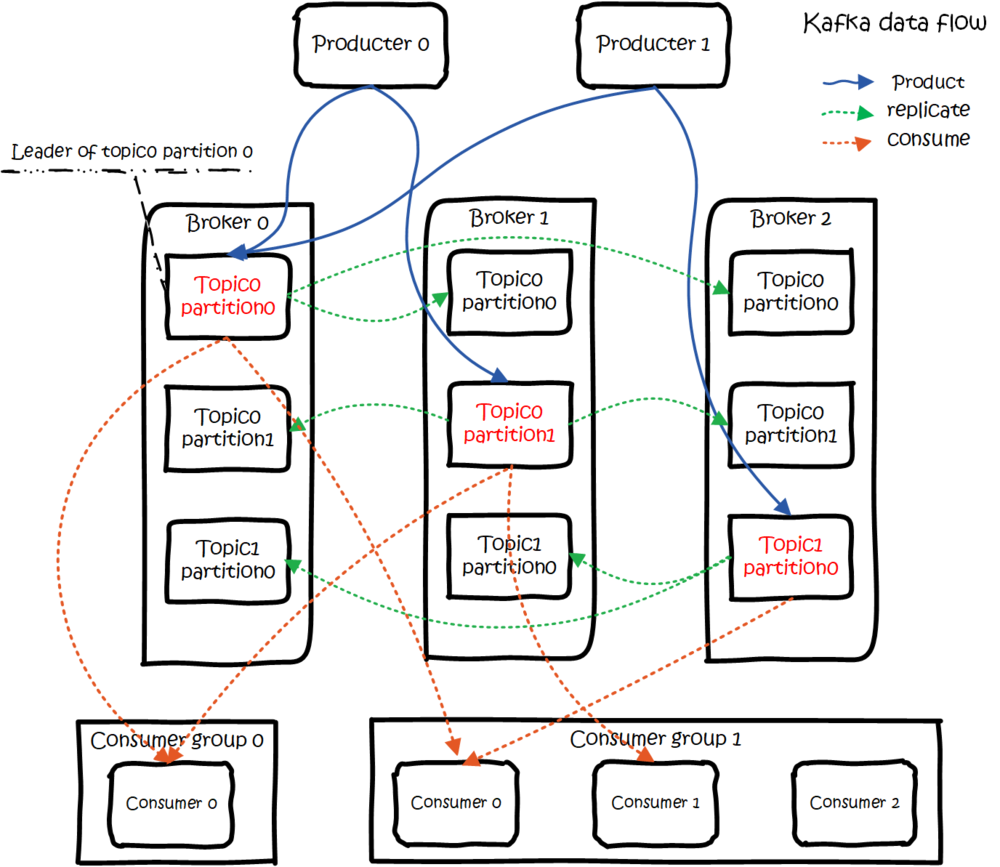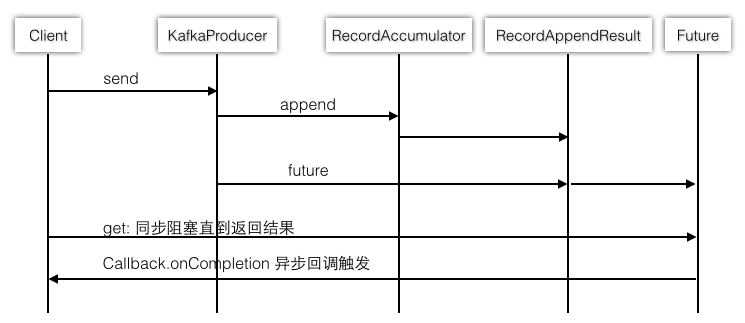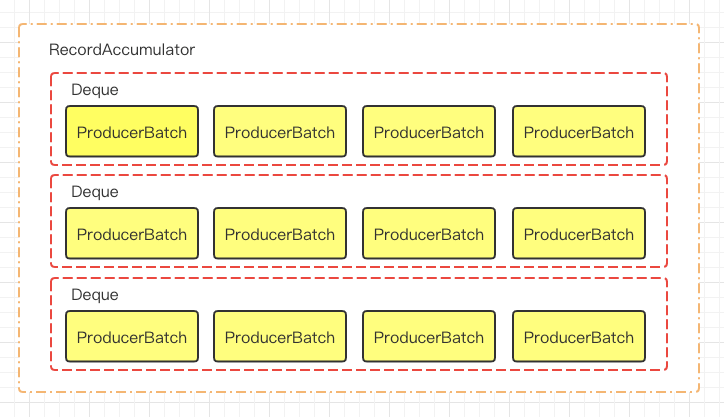Kafka源码分析及图解原理之Producer端
一.前言
任何消息队列都是万变不离其宗都是3部分,消息生产者(Producer)、消息消费者(Consumer)和服务载体(在Kafka中用Broker指代)。那么本篇主要讲解Producer端,会有适当的图解帮助理解底层原理。

一.开发应用
首先介绍一下开发应用,如何构建一个KafkaProducer及使用,还有一些重要参数的简介。
1.1 一个栗子
/**
* Kafka Producer Demo实例类。
*
* @author GrimMjx
*/
public class ProducerDemo {
public static void main(String[] args) throws ExecutionException, InterruptedException {
Properties prop = new Properties();
prop.put("client.id", "DemoProducer"); // 以下三个参数必须指定
// 用于创建与Kafka broker服务器的连接,集群的话则用逗号分隔
prop.put("bootstrap.servers", "localhost:9092");
// 消息的key序列化方式
prop.put("key.serializer", "org.apache.kafka.common.serialization.StringSerializer");
// 消息的value序列化方式
prop.put("value.serializer", "org.apache.kafka.common.serialization.StringSerializer"); // 以下参数为可配置选项
prop.put("acks", "-1");
prop.put("retries", "3");
prop.put("batch.size", "323840");
prop.put("linger.ms", "10");
prop.put("buffer.memory", "33554432");
prop.put("max.block.ms", "3000"); KafkaProducer<String, String> producer = new KafkaProducer<String, String>(prop);
try {
// 异步发送,继续发送消息不用等待。当有结果返回时,callback会被通知执行
producer.send(new ProducerRecord<String, String>("test", "key1", "value1"),
new Callback() {
// 返回结果RecordMetadata记录元数据包括了which partition的which offset
public void onCompletion(RecordMetadata metadata, Exception e) {
// 发送成功
if (e == null) {
System.out.println("The offset of the record we just sent is: " + metadata.offset()); // 发送失败
} else {
if (e instanceof RetriableException) {
// 处理可重试的异常,比如分区leader副本不可用
// 一般用retries参数来设置重置,毕竟这里也没有什么其他能做的,也是同样的重试发送消息
} else {
// 处理不可重试异常
}
}
}
}
); // 同步发送,send方法返回Future,然后get。在没有返回结果一直阻塞
producer.send(new ProducerRecord<String, String>("test", "key1", "value1")).get(); } finally {
// producer运行的时候占用系统额外资源,最后一定要关闭
producer.close();
}
}
}
注释已经写得十分详细了,参数的下面会说,这里就只说一下异步发送和同步发送。我们先看下KafkaProducer.send方法,可以看到返回的是一个Future,那么如何实现同步阻塞和异步非阻塞呢?

- 同步阻塞:send方法返回Future,然后get。在没有返回结果一直阻塞,无限等待
- 异步非阻塞:send方法提供callback,调用send方法后可以继续发送消息不用等待。当有结果返回时,callback会被通知执行

1.2 重要参数
这里分析一下broker端的重要参数,前3个是必要参数。Kafka的文档真的很吊,可以看这个类,每个参数和注释都解释的十分详细:org.apache.kafka.clients.producer.ProducerConfig
- bootstrap.server(必要):broker服务器列表,如果集群的机器很多,不用全配,producer可以发现集群中所有broker
- key.serializer/value.serializer(必要):key和value的序列化方式。这两个参数都必须是全限定类名,可以自定义拓展。
- acks:有3个值,0、1和all(-1)
- 0:produce不关心broker端的处理结果,吞吐量最高
- 1:produce发送消息给leader broker端,broker端写入本地日志返回结果,折中方案
- all(-1):配合min.insync.replicas使用,控制写入isr中的多少副本才算成功
- 思考:如果当前集群中ISR副本小于min.insync.replicas会发生什么,消费者还能正常消费吗?stack overflow地址:https://stackoverflow.com/questions/57231185/does-min-insync-replicas-property-effects-consumers-in-kafka
- buffer.memory:producer启动会创建一个内存缓冲区保存待发送的消息,这部分的内存大小就是这个参数来控制的
- commpression.type:压缩算法的选择,目前有GZIP、Snappy和LZ4。目前结合LZ4性能最好
- retries:重试次数,0.11.0.0版本之前可能导致消息重发
- batch.size:相同分区多条消息集合叫batch,当batch满了则发送给broker
- linger.ms:难道batch没满就不发了么?当然不是,不满则等linger.ms时间再发。延时权衡行为
- max.request.size:控制发送请求的大小
- request.timeout.ms:超过时间则会在回调函数抛出TimeoutException异常
- partitioner.class:分区机制,可自定义,默认分区器的处理是:有key则用murmur2算法计算key的哈希值,对总分区取模算出分区号,无key则轮询
- enable.idempotence:Apache Kafka 0.11.0.0版本用于实现EOS的利器
二.源码分析及图解原理
2.1 RecordAccumulator
上面介绍的参数中buffer.memory是缓冲区的大小,RecordAccmulator就是承担了缓冲区的角色。默认是32MB。
还有上面介绍的参数中batch.size提到了batch的概念,在kafka producer中,消息不是一条一条发给broker的,而是多条消息组成一个ProducerBatch,然后由Sender一次性发出去,这里的batch.size并不是消息的条数(凑满多少条即发送),而是一个大小。默认是16KB,可以根据具体情况来进行优化。
在RecordAccumulator中,最核心的参数就是:
private final ConcurrentMap<TopicPartition, Deque<ProducerBatch>> batches;
它是一个ConcurrentMap,key是TopicPartition类,代表一个topic的一个partition。value是一个包含ProducerBatch的双端队列。等待Sender线程发送给broker。画张图来看下:

再从源码角度来看如何添加到缓冲区队列里的,主要看这个方法:org.apache.kafka.clients.producer.internals.RecordAccumulator#append:
注释写的十分详细了,这里需要思考一点,为什么分配内存的代码没有放在synchronized同步块里?看起来这里很多余,导致下面的synchronized同步块中还要tryAppend一下,因为这时候可能其他线程已经创建好RecordBatch了。造成多余的内存申请。但是仔细想想,如果把分配内存放在synchronized同步块会有什么问题?
内存申请不到线程会一直等待,如果放在同步块中会造成一直不释放Deque队列的锁,那其他线程将无法对Deque队列进行线程安全的同步操作。那不是走远了?
/**
* Add a record to the accumulator, return the append result
* <p>
* The append result will contain the future metadata, and flag for whether the appended batch is full or a new batch is created
* <p>
*
* @param tp The topic/partition to which this record is being sent
* @param timestamp The timestamp of the record
* @param key The key for the record
* @param value The value for the record
* @param headers the Headers for the record
* @param callback The user-supplied callback to execute when the request is complete
* @param maxTimeToBlock The maximum time in milliseconds to block for buffer memory to be available
*/
public RecordAppendResult append(TopicPartition tp,
long timestamp,
byte[] key,
byte[] value,
Header[] headers,
Callback callback,
long maxTimeToBlock) throws InterruptedException {
// We keep track of the number of appending thread to make sure we do not miss batches in
// abortIncompleteBatches().
appendsInProgress.incrementAndGet();
ByteBuffer buffer = null;
if (headers == null) headers = Record.EMPTY_HEADERS;
try {
// check if we have an in-progress batch
// 其实就是一个putIfAbsent操作的方法,不展开分析
Deque<ProducerBatch> dq = getOrCreateDeque(tp);
// batches是线程安全的,但是Deque不是线程安全的
// 已有在处理中的batch
synchronized (dq) {
if (closed)
throw new IllegalStateException("Cannot send after the producer is closed.");
RecordAppendResult appendResult = tryAppend(timestamp, key, value, headers, callback, dq);
if (appendResult != null)
return appendResult;
} // we don't have an in-progress record batch try to allocate a new batch
// 创建一个新的ProducerBatch
byte maxUsableMagic = apiVersions.maxUsableProduceMagic();
// 分配一个内存
int size = Math.max(this.batchSize, AbstractRecords.estimateSizeInBytesUpperBound(maxUsableMagic, compression, key, value, headers));
log.trace("Allocating a new {} byte message buffer for topic {} partition {}", size, tp.topic(), tp.partition());
// 申请不到内存
buffer = free.allocate(size, maxTimeToBlock);
synchronized (dq) {
// Need to check if producer is closed again after grabbing the dequeue lock.
if (closed)
throw new IllegalStateException("Cannot send after the producer is closed."); // 再次尝试添加,因为分配内存的那段代码并不在synchronized块中
// 有可能这时候其他线程已经创建好RecordBatch了,finally会把分配好的内存还回去
RecordAppendResult appendResult = tryAppend(timestamp, key, value, headers, callback, dq);
if (appendResult != null) {
// 作者自己都说了,希望不要总是发生,多个线程都去申请内存,到时候还不是要还回去?
// Somebody else found us a batch, return the one we waited for! Hopefully this doesn't happen often...
return appendResult;
} // 创建ProducerBatch
MemoryRecordsBuilder recordsBuilder = recordsBuilder(buffer, maxUsableMagic);
ProducerBatch batch = new ProducerBatch(tp, recordsBuilder, time.milliseconds());
FutureRecordMetadata future = Utils.notNull(batch.tryAppend(timestamp, key, value, headers, callback, time.milliseconds())); dq.addLast(batch);
// incomplete是一个Set集合,存放不完整的batch
incomplete.add(batch); // Don't deallocate this buffer in the finally block as it's being used in the record batch
buffer = null; // 返回记录添加结果类
return new RecordAppendResult(future, dq.size() > 1 || batch.isFull(), true);
}
} finally {
// 释放要还的内存
if (buffer != null)
free.deallocate(buffer);
appendsInProgress.decrementAndGet();
}
}
附加tryAppend()方法,不多说,都在代码注释里:
/**
* Try to append to a ProducerBatch.
*
* If it is full, we return null and a new batch is created. We also close the batch for record appends to free up
* resources like compression buffers. The batch will be fully closed (ie. the record batch headers will be written
* and memory records built) in one of the following cases (whichever comes first): right before send,
* if it is expired, or when the producer is closed.
*/
private RecordAppendResult tryAppend(long timestamp, byte[] key, byte[] value, Header[] headers, Callback callback, Deque<ProducerBatch> deque) {
// 获取最新加入的ProducerBatch
ProducerBatch last = deque.peekLast();
if (last != null) {
FutureRecordMetadata future = last.tryAppend(timestamp, key, value, headers, callback, time.milliseconds());
if (future == null)
last.closeForRecordAppends();
else
// 记录添加结果类包含future、batch是否已满的标记、是否是新batch创建的标记
return new RecordAppendResult(future, deque.size() > 1 || last.isFull(), false);
}
// 如果这个Deque没有ProducerBatch元素,或者已经满了不足以加入本条消息则返回null
return null;
}
以上代码见图解:

2.2 Sender
Sender里最重要的方法莫过于run()方法,其中比较核心的方法是org.apache.kafka.clients.producer.internals.Sender#sendProducerData
其中pollTimeout需要认真读注释,意思是最长阻塞到至少有一个通道在你注册的事件就绪了。返回0则表示走起发车了
private long sendProducerData(long now) {
// 获取当前集群的所有信息
Cluster cluster = metadata.fetch();
// get the list of partitions with data ready to send
// @return ReadyCheckResult类的三个变量解释
// 1.Set<Node> readyNodes 准备好发送的节点
// 2.long nextReadyCheckDelayMs 下次检查节点的延迟时间
// 3.Set<String> unknownLeaderTopics 哪些topic找不到leader节点
RecordAccumulator.ReadyCheckResult result = this.accumulator.ready(cluster, now);
// if there are any partitions whose leaders are not known yet, force metadata update
// 如果有些topic不知道leader信息,更新metadata
if (!result.unknownLeaderTopics.isEmpty()) {
// The set of topics with unknown leader contains topics with leader election pending as well as
// topics which may have expired. Add the topic again to metadata to ensure it is included
// and request metadata update, since there are messages to send to the topic.
for (String topic : result.unknownLeaderTopics)
this.metadata.add(topic);
this.metadata.requestUpdate();
}
// 去除不能发送信息的节点
// remove any nodes we aren't ready to send to
Iterator<Node> iter = result.readyNodes.iterator();
long notReadyTimeout = Long.MAX_VALUE;
while (iter.hasNext()) {
Node node = iter.next();
if (!this.client.ready(node, now)) {
iter.remove();
notReadyTimeout = Math.min(notReadyTimeout, this.client.connectionDelay(node, now));
}
}
// 获取将要发送的消息
// create produce requests
Map<Integer, List<ProducerBatch>> batches = this.accumulator.drain(cluster, result.readyNodes,
this.maxRequestSize, now);
// 保证发送消息的顺序
if (guaranteeMessageOrder) {
// Mute all the partitions drained
for (List<ProducerBatch> batchList : batches.values()) {
for (ProducerBatch batch : batchList)
this.accumulator.mutePartition(batch.topicPartition);
}
}
// 过期的batch
List<ProducerBatch> expiredBatches = this.accumulator.expiredBatches(this.requestTimeout, now);
boolean needsTransactionStateReset = false;
// Reset the producer id if an expired batch has previously been sent to the broker. Also update the metrics
// for expired batches. see the documentation of @TransactionState.resetProducerId to understand why
// we need to reset the producer id here.
if (!expiredBatches.isEmpty())
log.trace("Expired {} batches in accumulator", expiredBatches.size());
for (ProducerBatch expiredBatch : expiredBatches) {
failBatch(expiredBatch, -1, NO_TIMESTAMP, expiredBatch.timeoutException());
if (transactionManager != null && expiredBatch.inRetry()) {
needsTransactionStateReset = true;
}
this.sensors.recordErrors(expiredBatch.topicPartition.topic(), expiredBatch.recordCount);
}
if (needsTransactionStateReset) {
transactionManager.resetProducerId();
return 0;
}
sensors.updateProduceRequestMetrics(batches);
// If we have any nodes that are ready to send + have sendable data, poll with 0 timeout so this can immediately
// loop and try sending more data. Otherwise, the timeout is determined by nodes that have partitions with data
// that isn't yet sendable (e.g. lingering, backing off). Note that this specifically does not include nodes
// with sendable data that aren't ready to send since they would cause busy looping.
// 到底返回的这个pollTimeout是啥,我觉得用英文的注释解释比较清楚
// 1.The amount of time to block if there is nothing to do
// 2.waiting for a channel to become ready; if zero, block indefinitely;
long pollTimeout = Math.min(result.nextReadyCheckDelayMs, notReadyTimeout);
if (!result.readyNodes.isEmpty()) {
log.trace("Nodes with data ready to send: {}", result.readyNodes);
// if some partitions are already ready to be sent, the select time would be 0;
// otherwise if some partition already has some data accumulated but not ready yet,
// the select time will be the time difference between now and its linger expiry time;
// otherwise the select time will be the time difference between now and the metadata expiry time;
pollTimeout = 0;
}
// 发送消息
// 最后调用client.send()
sendProduceRequests(batches, now);
return pollTimeout;
}
其中也需要了解这个方法:org.apache.kafka.clients.producer.internals.RecordAccumulator#ready。返回的类中3个关键参数的解释都在注释里。烦请看注释,我解释不好的地方可以看英文,原汁原味最好:
/**
* Get a list of nodes whose partitions are ready to be sent, and the earliest time at which any non-sendable
* partition will be ready; Also return the flag for whether there are any unknown leaders for the accumulated
* partition batches.
* <p>
* A destination node is ready to send data if:
* <ol>
* <li>There is at least one partition that is not backing off its send
* <li><b>and</b> those partitions are not muted (to prevent reordering if
* {@value org.apache.kafka.clients.producer.ProducerConfig#MAX_IN_FLIGHT_REQUESTS_PER_CONNECTION}
* is set to one)</li>
* <li><b>and <i>any</i></b> of the following are true</li>
* <ul>
* <li>The record set is full</li>
* <li>The record set has sat in the accumulator for at least lingerMs milliseconds</li>
* <li>The accumulator is out of memory and threads are blocking waiting for data (in this case all partitions
* are immediately considered ready).</li>
* <li>The accumulator has been closed</li>
* </ul>
* </ol>
*/
/**
* @return ReadyCheckResult类的三个变量解释
* 1.Set<Node> readyNodes 准备好发送的节点
* 2.long nextReadyCheckDelayMs 下次检查节点的延迟时间
* 3.Set<String> unknownLeaderTopics 哪些topic找不到leader节点
*
* 一个节点满足以下任一条件则表示可以发送数据
* 1.batch满了
* 2.batch没满,但是等了lingerMs的时间
* 3.accumulator满了
* 4.accumulator关了
*/
public ReadyCheckResult ready(Cluster cluster, long nowMs) {
Set<Node> readyNodes = new HashSet<>();
long nextReadyCheckDelayMs = Long.MAX_VALUE;
Set<String> unknownLeaderTopics = new HashSet<>();
boolean exhausted = this.free.queued() > 0;
for (Map.Entry<TopicPartition, Deque<ProducerBatch>> entry : this.batches.entrySet()) {
TopicPartition part = entry.getKey();
Deque<ProducerBatch> deque = entry.getValue();
Node leader = cluster.leaderFor(part);
synchronized (deque) {
// leader没有且队列非空则添加unknownLeaderTopics
if (leader == null && !deque.isEmpty()) {
// This is a partition for which leader is not known, but messages are available to send.
// Note that entries are currently not removed from batches when deque is empty.
unknownLeaderTopics.add(part.topic()); // 如果readyNodes不包含leader且muted不包含part
// mute这个变量跟producer端的一个配置有关系:max.in.flight.requests.per.connection=1
// 主要防止topic同分区下的消息乱序问题,限制了producer在单个broker连接上能够发送的未响应请求的数量
// 如果设置为1,则producer在收到响应之前无法再给该broker发送该topic的PRODUCE请求
} else if (!readyNodes.contains(leader) && !muted.contains(part)) {
ProducerBatch batch = deque.peekFirst();
if (batch != null) {
long waitedTimeMs = batch.waitedTimeMs(nowMs);
boolean backingOff = batch.attempts() > 0 && waitedTimeMs < retryBackoffMs;
// 等待时间
long timeToWaitMs = backingOff ? retryBackoffMs : lingerMs;
// batch满了
boolean full = deque.size() > 1 || batch.isFull();
// batch过期
boolean expired = waitedTimeMs >= timeToWaitMs;
boolean sendable = full || expired || exhausted || closed || flushInProgress();
if (sendable && !backingOff) {
readyNodes.add(leader);
} else {
long timeLeftMs = Math.max(timeToWaitMs - waitedTimeMs, 0);
// Note that this results in a conservative estimate since an un-sendable partition may have
// a leader that will later be found to have sendable data. However, this is good enough
// since we'll just wake up and then sleep again for the remaining time.
// 目前还没有leader,下次重试
nextReadyCheckDelayMs = Math.min(timeLeftMs, nextReadyCheckDelayMs);
}
}
}
}
}
return new ReadyCheckResult(readyNodes, nextReadyCheckDelayMs, unknownLeaderTopics);
}
还有一个方法就是org.apache.kafka.clients.producer.internals.RecordAccumulator#drain,从accumulator缓冲区获取要发送的数据,最大一次性发max.request.size大小的数据(最上面的配置参数里有):
/**
* Drain all the data for the given nodes and collate them into a list of batches that will fit within the specified
* size on a per-node basis. This method attempts to avoid choosing the same topic-node over and over.
*
* @param cluster The current cluster metadata
* @param nodes The list of node to drain
* @param maxSize The maximum number of bytes to drain
* maxSize也就是producer端配置参数max.request.size来控制的,一次最多发多少
* @param now The current unix time in milliseconds
* @return A list of {@link ProducerBatch} for each node specified with total size less than the requested maxSize.
*/
public Map<Integer, List<ProducerBatch>> drain(Cluster cluster, Set<Node> nodes, int maxSize, long now) {
if (nodes.isEmpty())
return Collections.emptyMap();
Map<Integer, List<ProducerBatch>> batches = new HashMap<>();
for (Node node : nodes) {
// for循环获取要发的batch
List<ProducerBatch> ready = drainBatchesForOneNode(cluster, node, maxSize, now);
batches.put(node.id(), ready);
}
return batches;
} private List<ProducerBatch> drainBatchesForOneNode(Cluster cluster, Node node, int maxSize, long now) {
int size = 0;
// 获取node的partition
List<PartitionInfo> parts = cluster.partitionsForNode(node.id());
List<ProducerBatch> ready = new ArrayList<>();
/* to make starvation less likely this loop doesn't start at 0 */
// 避免每次都从一个partition取,要雨露均沾
int start = drainIndex = drainIndex % parts.size();
do {
PartitionInfo part = parts.get(drainIndex);
TopicPartition tp = new TopicPartition(part.topic(), part.partition());
this.drainIndex = (this.drainIndex + 1) % parts.size(); // Only proceed if the partition has no in-flight batches.
if (isMuted(tp, now))
continue; Deque<ProducerBatch> deque = getDeque(tp);
if (deque == null)
continue; // 加锁,不用说了吧
synchronized (deque) {
// invariant: !isMuted(tp,now) && deque != null
ProducerBatch first = deque.peekFirst();
if (first == null)
continue; // first != null
// 查看是否在backoff期间
boolean backoff = first.attempts() > 0 && first.waitedTimeMs(now) < retryBackoffMs;
// Only drain the batch if it is not during backoff period.
if (backoff)
continue; // 超过maxSize且ready里有东西
if (size + first.estimatedSizeInBytes() > maxSize && !ready.isEmpty()) {
// there is a rare case that a single batch size is larger than the request size due to
// compression; in this case we will still eventually send this batch in a single request
// 有一种特殊的情况,batch的大小超过了maxSize,且batch是空的。也就是一个batch大小直接大于一次发送的maxSize
// 这种情况下最终还是会发送这个batch在一次请求
break;
} else {
if (shouldStopDrainBatchesForPartition(first, tp))
break; // 这块配置下面会讲
boolean isTransactional = transactionManager != null ? transactionManager.isTransactional() : false;
ProducerIdAndEpoch producerIdAndEpoch =
transactionManager != null ? transactionManager.producerIdAndEpoch() : null;
ProducerBatch batch = deque.pollFirst();
if (producerIdAndEpoch != null && !batch.hasSequence()) {
// If the batch already has an assigned sequence, then we should not change the producer id and
// sequence number, since this may introduce duplicates. In particular, the previous attempt
// may actually have been accepted, and if we change the producer id and sequence here, this
// attempt will also be accepted, causing a duplicate.
//
// Additionally, we update the next sequence number bound for the partition, and also have
// the transaction manager track the batch so as to ensure that sequence ordering is maintained
// even if we receive out of order responses.
batch.setProducerState(producerIdAndEpoch, transactionManager.sequenceNumber(batch.topicPartition), isTransactional);
transactionManager.incrementSequenceNumber(batch.topicPartition, batch.recordCount);
log.debug("Assigned producerId {} and producerEpoch {} to batch with base sequence " +
"{} being sent to partition {}", producerIdAndEpoch.producerId,
producerIdAndEpoch.epoch, batch.baseSequence(), tp); transactionManager.addInFlightBatch(batch);
}
// 添加batch,并且close
batch.close();
size += batch.records().sizeInBytes();
ready.add(batch); batch.drained(now);
}
}
} while (start != drainIndex);
return ready;
}
三.幂等性producer
上面说到一个参数,enable.idempotence。0.11.0.0版本引入的幂等性producer表示它的发送操作是幂等的,也就是说,不会存在各种错误导致的重复消息。(比如说瞬时的发送错误可能导致producer端出现重试,同一个消息可能发送多次)
producer发送到broker端的每批消息都会有一个序列号(用于去重),Kakfa会把这个序列号存在底层日志,保存序列号只需要几个字节,开销很小。producer端会分配一个PID,对于PID、分区和序列号的关系,可以想象成一个哈希表,key就是(PID,分区),value就是序列号。比如第一次给broker发送((PID=1,分区=1),序列号=2),第二次发送的value比2小或者等于2,则broker会拒绝PRODUCE请求,实现去重。
这个只能保证单个producer实例的EOS语义
Kafka源码分析及图解原理之Producer端的更多相关文章
- Kafka源码分析及图解原理之Broker端
一.前言 https://www.cnblogs.com/GrimMjx/p/11354987.html 上一节说过,任何消息队列都是万变不离其宗都是3部分,消息生产者(Producer).消息消费者 ...
- Kafka源码分析-序列2 -Producer
在上一篇,我们从使用方式和策略上,对消息队列做了一个宏观描述.从本篇开始,我们将深入到源码内部,仔细分析Kafka到底是如何实现一个分布式消息队列.我们的分析将从Producer端开始. 从Kafka ...
- Kafka源码分析系列-目录(收藏不迷路)
持续更新中,敬请关注! 目录 <Kafka源码分析>系列文章计划按"数据传递"的顺序写作,即:先分析生产者,其次分析Server端的数据处理,然后分析消费者,最后再补充 ...
- Kafka源码分析(三) - Server端 - 消息存储
系列文章目录 https://zhuanlan.zhihu.com/p/367683572 目录 系列文章目录 一. 业务模型 1.1 概念梳理 1.2 文件分析 1.2.1 数据目录 1.2.2 . ...
- Guava 源码分析(Cache 原理 对象引用、事件回调)
前言 在上文「Guava 源码分析(Cache 原理)」中分析了 Guava Cache 的相关原理. 文末提到了回收机制.移除时间通知等内容,许多朋友也挺感兴趣,这次就这两个内容再来分析分析. 在开 ...
- 深入源码分析SpringMVC底层原理(二)
原文链接:深入源码分析SpringMVC底层原理(二) 文章目录 深入分析SpringMVC请求处理过程 1. DispatcherServlet处理请求 1.1 寻找Handler 1.2 没有找到 ...
- 【转】MaBatis学习---源码分析MyBatis缓存原理
[原文]https://www.toutiao.com/i6594029178964673027/ 源码分析MyBatis缓存原理 1.简介 在 Web 应用中,缓存是必不可少的组件.通常我们都会用 ...
- Apache Kafka源码分析 – Broker Server
1. Kafka.scala 在Kafka的main入口中startup KafkaServerStartable, 而KafkaServerStartable这是对KafkaServer的封装 1: ...
- php中foreach源码分析(编译原理)
php中foreach源码分析(编译原理) 一.总结 编译原理(lex and yacc)的知识 二.php中foreach源码分析 foreach是PHP中很常用的一个用作数组循环的控制语句.因为它 ...
随机推荐
- 一起来学JavaScript吧(JS兔子领进门)
首先我们学习一门语言呢不一要学习它的所有历史,但是一定要知道它的使用基本规则.不要在最基础的部分出错.不过胡萝贝还是带你了解JavaScript的历史吧. 1994年网景公司(Netscape)发布了 ...
- Java——数据结构(链表)
链表,可扩展长度,泛型. public class Link { Node header = null; //头结点 int length;//当前链表长度 class Node { Node nex ...
- 从Dictionary源码看哈希表
一.基本概念 哈希:哈希是一种查找算法,在关键字和元素的存储地址之间建立一个确定的对应关系,每个关键字对应唯一的存储地址,这些存储地址构成了有限.连续的存储地址. 哈希函数:在关键字和元素的存储地址之 ...
- 帝国CMS(EmpireCMS) v7.5后台getshell分析(CVE-2018-18086)
帝国CMS(EmpireCMS) v7.5后台getshell分析(CVE-2018-18086) 一.漏洞描述 EmpireCMS 7.5版本及之前版本在后台备份数据库时,未对数据库表名做验证,通过 ...
- js高程3--面向对象的程序设计--创建对象
创建对象 这是js高程3--第6章面向对象的程序设计--第二节创建对象的总结与自己的理解,每一种模式都有自己的优点与缺点,搞清楚它们出现的历史原因,优缺点,我们才能使用的更加游刃有余! 本片文章并没有 ...
- Yii 三表关联 角色表、角色权限连接表、权限表
Yii 三表关联 角色表.角色权限连接表.权限表 角色表 role----------------id 唯一序号name 角色名称---------------- 角色权限连接表 lp-------- ...
- numba,让python速度提升百倍
python由于它动态解释性语言的特性,跑起代码来相比java.c++要慢很多,尤其在做科学计算的时候,十亿百亿级别的运算,让python的这种劣势更加凸显. 办法永远比困难多,numba就是解决py ...
- css3弹性盒子 flex布局
CSS3 弹性盒 1.display:flex 说明: 设置为弹性盒(父元素添加) 2.flex-direction(主轴排列方式) 说明: 顺序指定了弹性子元素在父容器中的位置 row 默认在一行内 ...
- caffe学习网站
1.http://www.cnblogs.com/denny402/tag/caffe/
- mybatis 源码分析(六)StatementHandler 主体结构分析
分析到这里的时候,mybatis 初始化.接口.事务.缓存等主要功能都已经讲完了,现在就还剩下 StatementHandler 这个真正干活的家伙没有分析了:所以接下来的博客内容主要和数据库的关系比 ...
